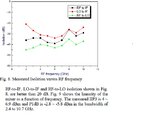jignesh_prajapati
Junior Member level 3
hi
i have designed down conversion mixer it isolation shows negative results(between -65 to -70)
many papers i have seen they consider it as positive means 65db isolation here one paper image link is attached
https://obrazki.elektroda.pl/2197191600_1431599923.jpg
please help
i have designed down conversion mixer it isolation shows negative results(between -65 to -70)
many papers i have seen they consider it as positive means 65db isolation here one paper image link is attached
https://obrazki.elektroda.pl/2197191600_1431599923.jpg
please help
